A fluorocarbon fishing line has several properties that make it different than a standard monofilament line. The reason most anglers use a fluorocarbon line or leader is that in some cases it is less visible to the fish. People marketing fluorocarbons may say it is invisible underwater but this is not true
Fluorocarbon has an index of refraction of 1.42, a standard monofilament line is around 1.55 and water is 1.33. Since the fluorocarbon line has an index of refraction closer to water it will bend and reflect less light in certain conditions. The thinner the line the less visible it will be to fish. So if fish can be seen but are not biting going to a thin fluorocarbon line is an option that produces results in some cases.
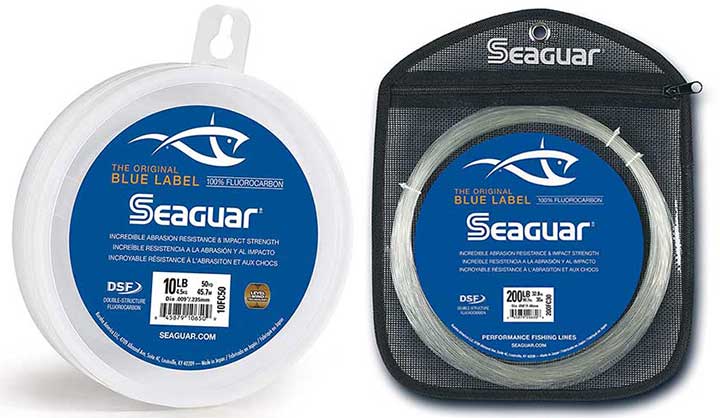
The second most common reason anglers use fluorocarbon line is that it is more abrasion resistant than monofilament line. This comes into play way catching many types of fish like bass, snook, and tarpon that have rough mouths that can wear through a line. Also, abrasion resistance is very important when catching billfish such as sailfish, marlin, and swordfish.
Next anglers use fluorocarbon lines in some cases because it is denser and sinks in water. Since the line sinks, there is less slack in the line when dropping baits and jigs. The fluorocarbon line is stiffer than standard monofilament which can help the line from getting bunched up underwater but can limit the action of small live baits.
For fishing lines over 20 pounds, and standard monofilament is typically used for the mainline because fluorocarbon is too stiff. Just using a fluorocarbon leader is also less expensive. Fluorocarbon leaders are a great idea when using a braided main fishing line.
Here Are the Best Fluorocarbon Leader Lines
1. Ande Fluorocarbon Leader Line
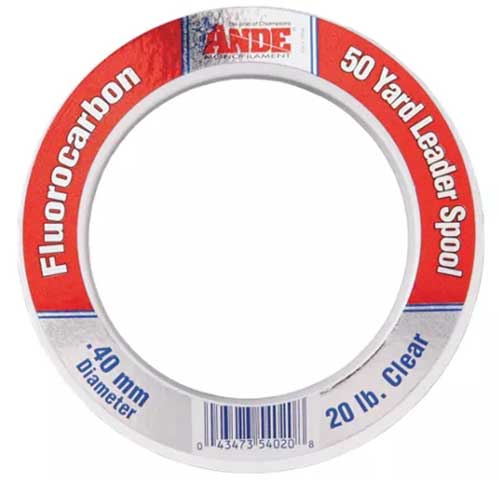
| Pound Test | 10, 12, 15, 20, 25, 30, 40, 50, 60 |
| 20lb Diameter | 0.44 mm |
| 20lb Cost Per Yard | $0.042 |
| Color | Clear or Pink |
| Length in Yards | 50 |
| Made in | Italy |
Ande makes high-quality leader material at a reasonable price point. Using a 20-pound test is perfect for bass fish and a 50-pound test is good for tarpon and striped bass. The wrist spool the line comes on is a good way to store the line. Fluorocarbon should last for up to seven years if stored properly. The spool contains 50 yards of the fluorocarbon leader line. I use Ande leader line for both freshwater and saltwater and think it is the best for strength and low visibility under the water.
Like most fluorocarbon Ande line is clear, abrasion-resistant, and heavier than water. The line is stiff and does not stretch as much as traditional monofilament. When fishing with braid and fluorocarbon leaders there will be little stretch in the line. This can be good to get a quick hookset but does not absorb quick movements from strong fish. For this reason, reels with quality drag and somewhat flexible poles should be used when fishing with braid and fluorocarbon.
2. Seaguar Blue Label Fluorocarbon Leader Line
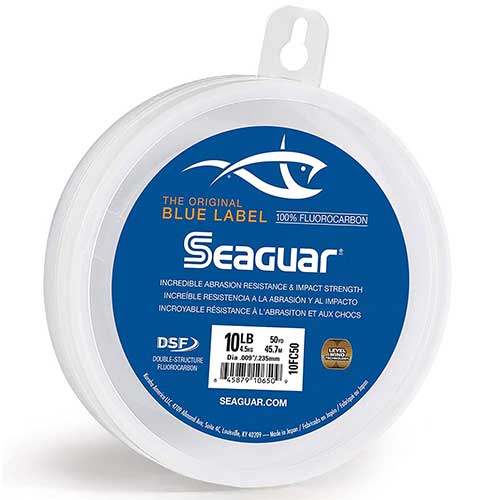
| Pound Test | 10, 12, 15, 20, 25, 30, 40, 50, 60, 80 |
| 20lb Diameter | 0.405 mm |
| 20lb Cost Per Yard | $0.039 |
| Color | Clear |
| Length in Yards | 50 |
| Made in | Japan |
Seaguar Blue Label fluorocarbon is one of the most most popular fluorocarbon leaders. This is a double structure fluorocarbon that uses two fluorocarbon resins that make the line in a co-extrusion process. This line is low-visibility, abrasion resistant, has a high knot strength, and is fast sinking.
This line comes in 25, 50, and 100 yards spools. Typically leaders are about 5 feet long for fish like bass, crappie, trout, and tarpon. Leaders are often made ten feet or longer when fishing for tuna, yellowtail snapper, and mutton snapper which can be leader shy. Sometimes fish are not leader shy and even tuna which have great eyesight will bite a thick wireline. However, there are times when the water clarity, sunlight, and fish activity level make having a less reflective fluorocarbon leader an advantage. Sometimes just using a fluorocarbon leader is not enough and the angler should use a smaller diameter fluorocarbon leader. This is common when fish or highly pressured salmon, trout, and snappers.
When fishing in dirty water it is also important to keep the line clean. Dirt can build up on the line making it more visible. Wiping the line with a clean cloth can help make the line less visible at times. Also if fluorocarbon was on a small spool if often has coil memory, stretch the leader line straight to make it less visible.
3. Seaguar Blue Label Big Game Fluorocarbon Leader
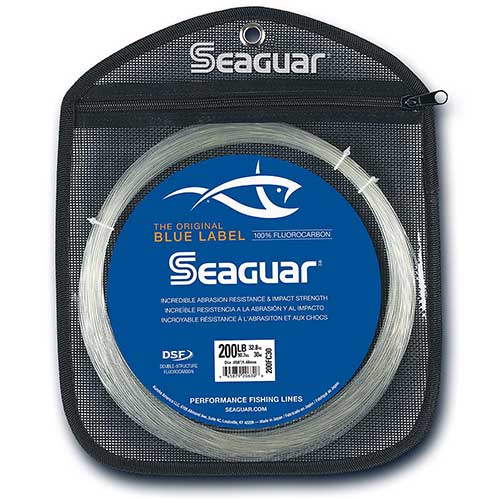
| Pound Test | 100, 130, 150, 180, 200, 220 |
| 200lb Diameter | 1.48 mm |
| 200lb Cost Per Yard | $3.58 |
| Color | Clear |
| Length in Yards | 32.8 |
| Made in | Japan |
This is the same Seaguar Blue Label fluorocarbon but is found at a much higher strength. The fluorocarbon leader line comes in a 32.8-yard spool in a reusable mesh bag with a zipper. When making shock leaders for wahoo or swordfish with a braided mainline standard monofilament line should be used because it has more stretch. Heavy fluorocarbon is used because it is less visible and abrasion-resistant. The leader for billfish should be fluorocarbon or heavy monofilament as the bill rubs on the line a can break the monofilament line easier.
When trolling offshore for tuna, marlin, and mahi-mahi it is common to use 100-200 pound, fluorocarbon leaders. The leader will need to be attached with crimps as the line will be to thick to tie with most fishing knots. When using an 80-pound line fishing knots like the palmer knot can still be used. Some anglers even use 200-pound fluorocarbon when a wahoo might be caught when trolling for other pelagic fish. Wahoo teeth can defiantly cut 200-pound fluorocarbon but some wahoo lures typically catch the corner of the mouth and the teeth will be over the lure, not the line. The heavy line offers some protection from the initial bite but the line still might get cut.
4. Seaguar Fluorocarbon Premier Leader Line
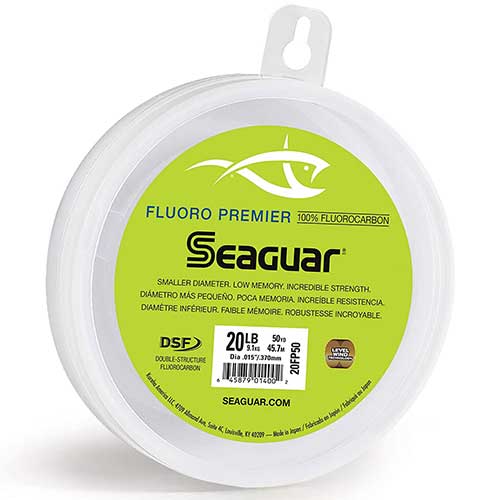
| Pound Test | 20, 25, 30, 40, 50, 60, 80, 100, 130, 150, 170, 200 |
| 20lb Diameter | 0.370 mm |
| 20lb Cost Per Yard | $0.45 |
| Color | Clear |
| Length in Yards | 50 |
| Made in | Japan |
Seaguar Premier fluorocarbon has a very small diameter making in less visible than most other lines. Seaguar Gold fluorocarbon is slightly thinner but currently only comes in line strengths from 15-40 pounds.
This line is made with double structure fluorocarbon which is a blend of two resins. It is a great line to use when low visibility and abrasion resistance are important for fishing conditions.
5. Yo-Zuri HD Carbon Fluorocarbon Leader
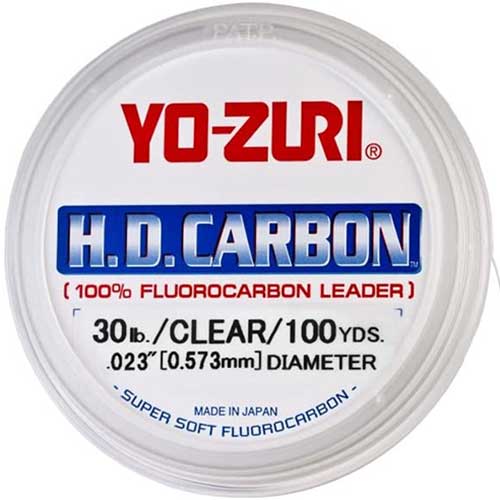
| Pound Test | 8, 10, 15, 20, 25, 30, 40, 50, 60, 80, 100, 130, 150, 200 |
| 20lb Diameter | 0.438 mm |
| 20lb Cost Per Yard | $0.43 |
| Color | Clear or Pink |
| Length in Yards | 30 or 100 |
| Made in | Japan |
Yo-Zuri H.D. fluorocarbon is another very popular line with saltwater anglers. Fluorocarbon is less visible underwater than standard monofilament unless the line gets nicked and damages. This Yo-Zuri blend is resistant to nicks and scrapes. Some anglers also say that pink fluorocarbon is better at staying clear once the line is nicked or roughed up.
Like all fluorocarbon this is abrasion-resistant. This is labeled as super soft fluorocarbon with less memory than others on the market. It comes in 30-yard and 100-yard spools.
6.Yo-Zuri HD Carbon Pink Fluorocarbon Leader
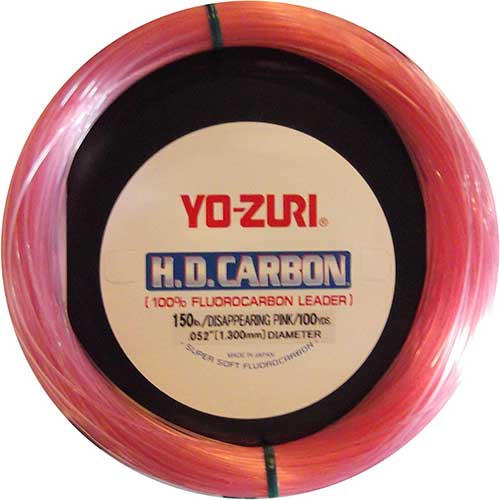
| Pound Test | 8, 10, 15, 20, 25, 30, 40, 60, 80, 100, 130, 200, 300 |
| 200lb Diameter | 1.48 mm |
| 200lb Cost Per Yard | $3.0 |
| Color | Pink |
| Length in Yards | 30 |
| Made in | Japan |
Yo-Zuri H.D. fluorocarbon also comes in disappearing pink. This comes is a 30-yard spool with line sizes up to 300 pounds. Pink and red are known to be a color that disappears after about 20 feet of water depth. This makes pink a popular color for bottom fishing.
Some anglers also like pink so they can see their line above water. Personally, I use clear leaders but some people like pink leaders and Ande pink monofilament is also popular for bottom fishermen that want to spend less money.
7. Hi-Seas Fluorocarbon Leader Line
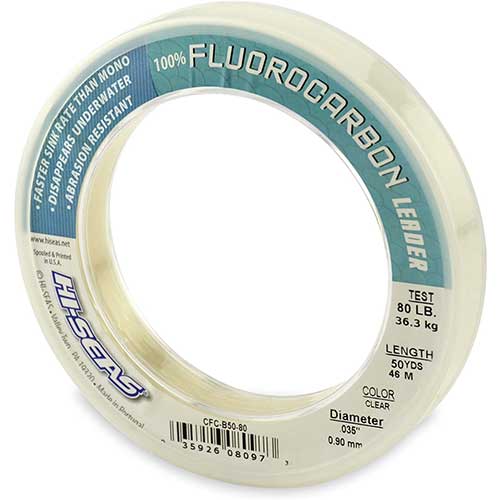
| Pound Test | 12, 15, 20, 25, 30, 40, 50, 60, 80, 100, 130, 175, 220, 330 |
| 20lb Diameter | 0.40 mm |
| 20lb Cost Per Yard | $0.32 |
| Color | Clear |
| Length in Yards | 25 or 50 |
| Made in | USA, Portugal |
Hi-Seas fluorocarbon leader is one of the thinnest fluorocarbon leaders on the market. It is also found at a lower price point than many popular fluorocarbon leaders. This line is labeled as having a faster sink rate than monofilament, disappears underwater, and abrasion-resistant.
This Hi-SEAS line is extruded with 100 percent fluorocarbon with a high-quality control process. Using a fluorocarbon leader is a good idea when a low visible line with abrasion resistance is needed. These leaders are commonly tied to the end of a braided line with a line-to-line connection that is tied with a double uni-knot. When bass fishing I typically use a 20-pound braided line with a 5-foot fluorocarbon leader. This allows for a strong low visibility setup that can be cast a far distance.
8. Triple-Fish Fluorocarbon Leader Material
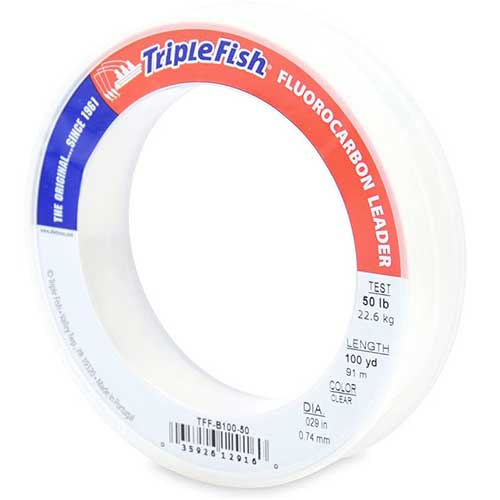
| Pound Test | 4, 6, 8, 12, 20, 25, 30, 40, 50, 60, 80, 100 |
| 20lb Diameter | 0.40 mm |
| 20lb Cost Per Yard | $0.40 |
| Color | Clear |
| Length in Yards | 25 or 100 |
| Made in | Portugal |
Triple Fish fluorocarbon and monofilament leader material are widely used by saltwater anglers. This fluorocarbon leader has a small diameter for a given strength and is a reasonable price.
Triple fish monofilament leader material is also commonly sold in stores. Make sure to get the fluorocarbon version when the conditions require low visibility and high abrasion resistance.
9. Momoi’s Hi-Catch Fluorocarbon Fishing Line
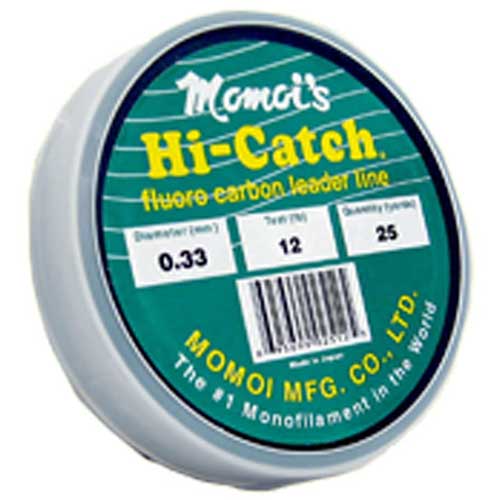
| Pound Test | 8, 10, 15, 20, 25, 30, 40, 60, 80, 100, 130, 200, 300 |
| 20lb Diameter | 0.41 mm |
| 20lb Cost Per Yard | $0.51 |
| Color | Clear |
| Length in Yards | 25 |
| Made in | Japan |
Momoi’s Hi-Catch is a high-end fluorocarbon leader. It is expensive but is good leader material. Like other fluorocarbons, it is a dense line that sinks and absorbs very little water. The company Momoi is also known for making a quality standard monofilament fishing line. I have used this leader to catch tarpon many times and it works very well. Even with their abrasive mouths I never lost a tarpon due to a frayed leader. Sure tarpon throws the hooks a lot but that is part of tarpon fishing.
10. Berkley Pro-Spec Fluorocarbon Leader Material
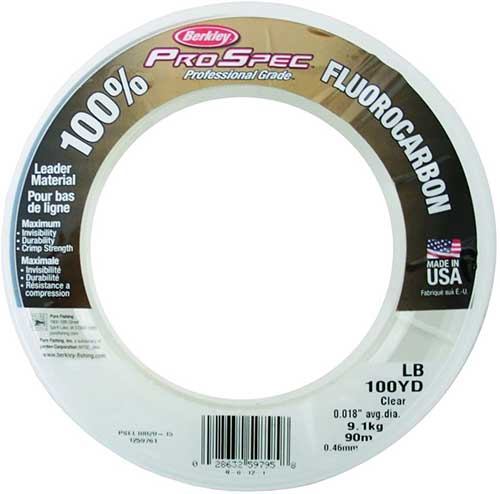
| Pound Test | 20, 25, 30, 40, 50, 60, 80 |
| 20lb Diameter | 0.45 mm |
| 20lb Cost Per Yard | $0.298 |
| Color | Clear |
| Length in Yards | 25, 75, or 100 |
| Made in | USA |
Berkley Pro-Spec is a fluorocarbon leader that is made in the USA. It is an average quality fluorocarbon that is found at a competitive price point. This line can be used in both freshwater and saltwater. It is labeled as maximum invisibility, durability, and crimp strength. This line comes in 25, 75, and 100-yard wrist spools. It also comes in a 33-yard clear coil with a re-usable bag.
11. Berkley Vanish Fluorocarbon Fishing Line
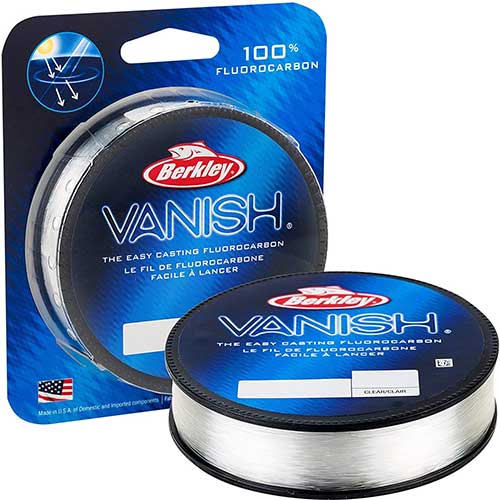
| Pound Test | 2, 4, 6, 8, 10, 12, 14, 20, 30, 40 |
| 20lb Diameter | 0.40 mm |
| 20lb Cost Per Yard | $0.062 |
| Color | Clear |
| Length in Yards | 110, 250, 350, or 2000 |
| Made in | USA |
Berkley Vanish fluorocarbon is a fishing line not just a leader material. That being said the line is very similar in diameter to most fluorocarbon leader materials. It is also abrasion-resistant. For these reasons, it would work well as leader material for braided or monofilament lines. The line is made with 100 percent soft low-memory fluorocarbon and is not fluorocarbon coated. I would recommend using this line rather than any monofilament line under 10 pounds.
This line is also flexible and easy to cast compared to other fluorocarbon lines. For small diameters around 4-6 pounds, the line is very flexible. The line is made in 30 and 40-pound tests which are higher than most fluorocarbon lines. This is because the line will not cast as far with spinning reels. However, the heavy fluorocarbon line can be used on conventional fishing reels.
12. Stren Fluorocast Fluorocarbon Fishing Line
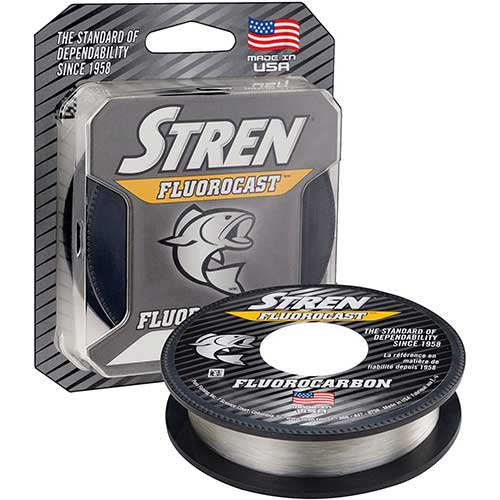
| Pound Test | 6, 8, 10, 15, 17 |
| 17lb Diameter | 0.40 mm |
| 17lb Cost Per Yard | $0.050 |
| Color | Clear |
| Length in Yards | 100 or 200 |
| Made in | USA |
Stern Fluorocast is another good fluorocarbon fishing line. It is made for tests between 6 and 17 pounds. Using a fluorocarbon line is easier than using braided or nylon monofilament with a leader as there is an extra knot in that setup. That knot reduces the over line strength and creates a weak spot that is around 80 percent of the overall line strength.
The 17-pound Stern Fluorocast has a diameter of 0.40 mm which is the diameter of 20-pound Berkley Vanish. For that reason, I think Berkley Vanish is a better product but the two lines are very similar. These lines are sensitive for felling bites and offer some stretch to absorb shock while catching a thrashing fish. This line has good knot strength, low visibility underwater, and is a sinking line that helps get baits and lures deep in the water.
13. Seaguar Red Label Fluorocarbon Fishing Line
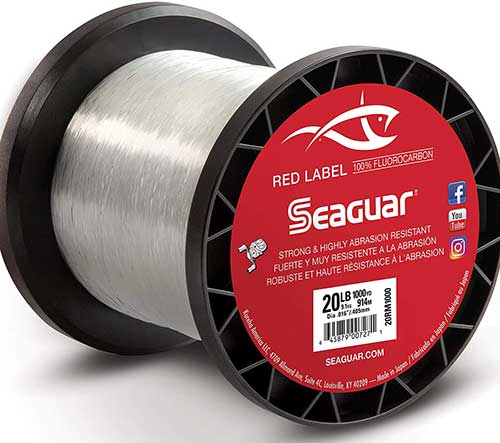
| Pound Test | 6, 8, 10,12, 15, 20 |
| 20lb Diameter | 0.405 mm |
| 20lb Cost Per Yard | $0.053 |
| Color | Clear |
| Length in Yards | 200 or 1000 |
| Made in | Japan |
Seaguar Red Label Fluorocarbon is a fishing line not what is typically used as leader material. It is 100 percent fluorocarbon, abrasion-resistant, low-visibility, has good knot strength, and is very sensitive. This would be a good line to use on conventional reels when trolling. I think the Berkley Vanish is the better fluorocarbon line but some angels prefer Seaguar fishing line.
14. Maxima Fluorocarbon Fishing Line
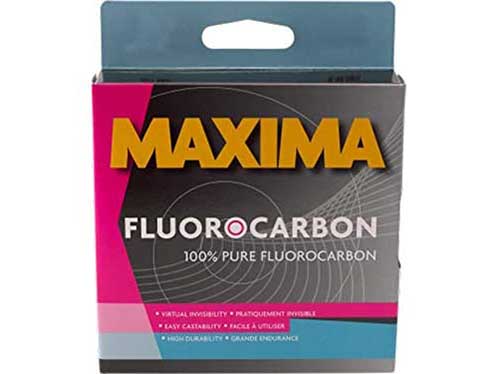
| Pound Test | 2, 3, 6, 8, 10, 12, 15, 20, 30, 40 |
| 20lb Diameter | 0.41 mm |
| 20lb Cost Per Yard | $0.053 |
| Color | Clear |
| Length in Yards | 200 |
| Made in | USA or Germany |
Maxima fluorocarbon is a fishing line, not a typical leader material. It is labeled as virtually invisible, easy cast, and high durability. It is 100 percent fluorocarbon and is not a coated line. This means the line will be abrasion-resistant and sink in the water. A fluorocarbon line breaks down much slower when exposed to UV light than a standard monofilament line. This allows the line to have a longer storage life and lasts longer when in use.
Maxima ultra-green is not a fluorocarbon line but is commonly used as the mainline on salmon reels and leader material when salmon fishing.
15. P-line Floroclear Clear Fishing Line
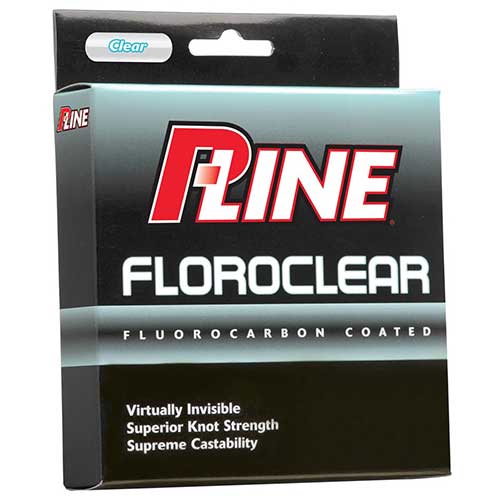
| Pound Test | 2, 3, 4, 6, 8, 10,12, 15, 20, 25, 30 |
| 20lb Diameter | 0.41 mm |
| 20lb Cost Per Yard | $0.030 |
| Color | Clear |
| Length in Yards | 260 or 300 |
| Made in | Japan |
This P-line is a fluorocarbon coated leader. It is labeled as virtually invisible, superior knot strength, and supreme castability.
The reason to use a fluorocarbon coated line is to get some advantages of 100 percent fluorocarbon and some advantages of nylon monofilament. It is soft, flexible, and has low memory which allows for far casting. The coating also helps reduce line visibility. A drawback is that it will likely not be as abrasion resistant as a 100 percent fluorocarbon line.
16. P-Line Premium Fluorocarbon Leader Line
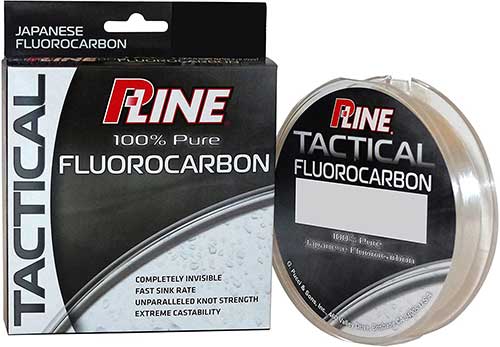
| Pound Test | 6, 8, 10,12, 17, 20 |
| 20lb Diameter | 0.418 mm |
| 20lb Cost Per Yard | $0.147 |
| Color | Clear |
| Length in Yards | 260 or 300 |
| Made in | Japan |
This is P-Line Tactical 100 percent fluorocarbon fishing line. It is labeled as, completely invisible, fast sink rate, unparalleled knot strength, and extreme castability.
The line is three times as dense as a nylon fishing line allowing it to sink faster and be more sensitive to bites. It also offers abrasion resistance. This is known for being a quality fluorocarbon line but is considerably more expensive than similar lines. It is also not as thin for a given strength as other fluorocarbon lines on this list.
17. KastKing Fluorokote Fluorocarbon Coated Fishing Line
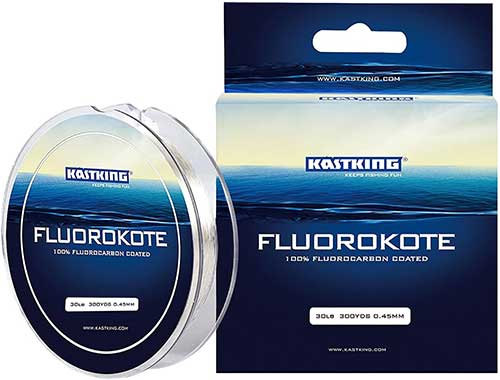
| Pound Test | 4, 6, 8, 10,12, 15, 17, 25, 30 |
| 20lb Diameter | 0.38 mm |
| 20lb Cost Per Yard | $0.043 |
| Color | Clear |
| Length in Yards | 260 or 300 |
| Made in | China |
The KastKing Fluorokote is a fluorocarbon coated fishing line. This is a popular line largely due to its low cost. It has a polymer blend core and is not 100 percent fluorocarbon. If budget is a factor this is a decent fishing line. I am surprised the listed diameter is smaller than many pure fluorocarbon lines on this list. It would be interesting to test the measure line diameter, clarity, abrasion resistance, and knot strength of this line to other similar lines on the market.
Frequently Asked Questions
Does fluorocarbon leader make a difference?
Yes, a fluorocarbon leader line can make a difference in some situations. It has several differences that can be considered an advantage or a disadvantage depending on the situation. First, fluorocarbon can be less visible than monofilament because the index of refraction of 1.42 which is close to the 1.33 value of water. Second, fluorocarbon is dense which makes it abrasion resistant, thin, and sinks in the water. Sometimes when fishing a small floating topwater lure a sinking line is not desirable. Also since the line is denser, it is also stiffer than nylon monofilament which makes it more difficult to cast if it is used for the entire length of the line.
Fluorocarbon is great to use a leader in most cases. Fluorocarbon helps against abrasive mouths of fish like bass, tarpon, and snook. However, it does not prevent sharp teeth from a shark, wahoo, and mackerel from cutting the line which is why single strand wire or multi-strand cable is typically used. Also, some fish spices like salmon and halibut are not leader shy and a standard monofilament line can be used without changing the catch rates.
How much fluorocarbon leader should I use?
There are two important factors that determine the visibility of fluorocarbon to fish. The length of the leader and the thickness of the leader. Fourcarbon is less visible to fish but is not invisible. Some days fish are aggressive and will bite on a thin metal wire. Other day’s conditions are such that fish are skittish and will not bite large rigs with a heavy line. My typical leader length for casting is about 5 feet. This makes it so the knot does not have to go through the eye of the pole reducing the casting distance.
When trolling a good leader length is 6 feet and the lure should be attached with a good ball bearing swivel. Some fish such as mutton snapper requires a long 30 foot plus leader lengths. Other fish like yellowtail snapper might require going from a 20-pound test fluorocarbon to a 10-pound test fluorocarbon in order to get bites. Thinner fishing lines are less visible to fish than thicker lines.
Should I use monofilament or fluorocarbon?
Fluorocarbon leaders are almost always a good idea. When using a fishing line that is less than a 10-pound test fluorocarbon for the entire line is a good idea. For spinning reels and baitcasting reels using a braided mainline allows for the furthest casting. When using a braided line fluorocarbon leaders should almost always be used. Fluorocarbon lines are made up to 40 pounds which can be used on conventional fishing reels. This line is stiffer with more stretch than a braided line and less stretch than a nylon monofilament line. If abrasion resistance or using a low visibility line is important fluorocarbon should be used. Abrasion resistance can be important from the standpoint of the fish’s mouth as well as the bottom or other areas that the line might rub on.
What are the best knots for fluorocarbon leaders?
The best knots for fluorocarbon leaders are the unit knot and the Palomar knot for attaching hooks. When attaching the leader to a braided or monofilament line the double uni knot is quick and effective. Perfection loops and dropper loops are also commonly used to tie leaders. The video below shows the best fishing knots to use for all types of fishing situations.
Do I need a leader on braided line?
In almost all cases leaders are a good idea with a braided line. Some fish like halibut and catfish are not leader shy and so braided line can be used without a fluorocarbon leader. Sometimes the desirable leader’s strength should be more or less than the mainline. In these cases, a heavy braided line, single-strand wire, multistrand cable, or fluorocarbon line should be used as the leader.
The visibility of a braided line depends on the color of the braid and the color of the environment. Common colors of braided lines are white, yellow, black, and green. White is probably the best color at having love visibility in clear water. When fish look up the sky is a light color and white is good camouflage. In stained, murky, or low light conditions a dark green is a low visitability braided line.
What is the leader line?
A leader line is the last 3-20 feet of line that is connected to a hook or lure. It is connected to the mainline with a swivel or line-to-line connection such as the double uni knot. The leader line can be a variety of materials including a fluorocarbon line, nylon monofilament line, multi-strand cable, single strand wire, braided line, or even a rope such as a solid braid nylon core ganyen leader line. It is common to use a leader line that is stronger than the mainline to account for any damage that may come to the line from rubbing on the bottom, cut by the fish’s teeth, or when rubbing against an abrasive fish’s body.
Which is stronger mono or fluorocarbon?
The strength of a given fish line depends on several factors. There is the line strength, knot strength, shock absorbance, abrasion resistance, and cut resistance. The line strength can be from 2 pounds to 400 pounds but the diameter of the line increases as the line gets stronger. It is good to compare the thickness of the line at a given pound test. In this article, the line diameter is given for a 20-pound test line. Fluorocarbon and monofilament have similar line diameters and it varies depending on the brand and model of the line. The thinnest diameter fluorocarbon leader line on the market is Seaguar gold. For a 100 percent fluorocarbon fishing line that is used for the entire spool, the thinnest diameter is Berkley Vanish.
How long does a fluorocarbon line last?
A fluorocarbon line lasts longer than a standard nylon monofilament because it does not breaks down as fast from UV light. The shelf life of fluorocarbon is about 7 years. Once fluorocarbon is on a reel and used it should be replaced once a year at the beginning of the season. If it is rarely used it should last two or three years. When using an old line always test the knot strength by pulling hard on the line. If it does not break easier than expected it should work. Once you have a line break with properly set drag it is time to replace the fishing line.
Is fluorocarbon good for baitcasters?
This short answer is no fluorocarbon is not good for baitcasters. Fluorocarbon is not as soft as standard nylon and will bird nests easier. Some fluorocarbon brands are softer than others. If it is a fluorocarbon fishing line and under 10 pounds an experienced angler could use a baitcaster reel. A braided fishing line is the easiest to use with a baitcaster and then a fluorocarbon leader can be added.
Can you use fluorocarbon as a mainline?
Yes, fluorocarbon line from 2 pounds to 40 pounds can be used as the mainline. Fluorocarbon under 10 pounds works best for spinning reels. Large fluorocarbon can be used on convection fishing reels when trolling and jigging. When trout, steelhead, and salmon fishing a fluorocarbon mainline is nice because a leader is not needed. A fluorocarbon mainline is also nice when fishing for yellowtail snapper.
Should leaders be heavier than the mainline?
Yes in most cases a leader should be stronger and heavier than the mainline. This is because the line might rub against rocks or be damaged by the fish’s teeth. Fluorocarbon is great leader material because it has low visibility and is abrasion-resistant. Another good leader material is single strand wire or multi-strand cable when fish have sharp teeth.
Is a fluorocarbon line really invisible?
No fluorocarbon line is not invisible above water or underwater. This is mostly a false marketing technique to get anglers to buy a really expensive fishing line. It is less visible under certain conditions. When direct sunlight hits a fishing line the reflection can scare away fish. With fluorocarbon, the reflection is still there but it is not as much. The thinner a fishing line is the less visible it should be. This is why using a 2-6 pound test is common when trout fishing for example.
Is fluorocarbon hard to cast?
Yes, fluorocarbon is harder to cast than a nylon monofilament or braided line of the same strength. This is because the line is denser and stiffer than these other lines. The result is that it will not cast as far. There are advantages of using fluorocarbon though and if the line is under a 10-pound test is should be cast about the same as the other lines.
Can you use fluorocarbon on a spinning reel?
Yes, a fluorocarbon line can be used on a spinning reel. It will not cast as far as a standard nylon line or braided line. Braided lines cast the furthest since they are lightweight and extremely flexible. Braided lines are quite visible to the fish though which is why fluorocarbon leaders are almost always used.
What’s better braided or fluorocarbon?
Braided line and fluorocarbon are two very different types of line and are better in different situations. For a mainline fluorocarbon is only common for less than a 10-pound test. A braided line is a great mainline from 10 pounds to 200 pounds. Both braided line and fluorocarbon are abrasion-resistant. Fluorocarbon is a much better leader material though since it is less visible under most conditions.
What is fluorocarbon made of?
Fluorocarbon material is a fluoropolymer PVDF. This material starts as a resin and is then extruded into a fishing line. Most Seaguar leader material is double structure fluorocarbon that is made in a co-extrusion process. PVDF is a desirable line material because it has an index of refraction that is close to that of water. This makes the line less visible to the fish. It is also a dense fishing line that sinks and holds up well to knicks and scrapes.
Does fluorocarbon have memory?
Yes, a fluorocarbon line is a type of monofilament and has memory. Memory is actually a good thing in most cases. It is important to spool monofilament and fluorocarbon lines at least the night before using it. If not the line is more likely to get tangled coming on and off the spool. When using fluorocarbon as a leader it is important to remove the memory from the line. This can be done by pulling hard on the line. This will stretch the line for a second which removes most of the memory in the line. A straight line is less visible than a line with curly wraps.
When was fluorocarbon invented?
Fluorocarbon was invented in 1971 by people working at Seaguar. Many anglers will say you need fluorocarbon to catch tuna or trout but there was plenty of tuna and trout caught before the fluorocarbon line was invented. There are advantages of this line though as it is a tougher less visible line. A heavier line can be used as still be equivalent to the visibility of a smaller diameter nylon line. Fluorocarbon is both tougher and less visible in most fishing situations.
Can fish bite through fluorocarbon?
Yes, some fish can absolutely bite through fluorocarbon. When it comes to large sharp teeth of fish fluorocarbon offers about the same durability as a standard nylon fishing line. It is more abrasion resistant which is good for fish that have sandpaper-like teeth. The line is also very durable when rubbing against the bills of sailfish, marlin, and swordfish.
Captain Cody has worked on charter fishing boats in the Florida Keys, Virgin Islands, and Alaska. Growing up in Pennsylvania Cody has also done extensive freshwater fishing including bass fishing tournaments. Cody strives to provide detailed information about the best fishing gear and tactics to help both novice and experienced anglers have a more productive and enjoyable time on the water. Cody also has a background in aerospace engineering and neuroscience but really only takes pride in being good at one thing and that is fishing!
